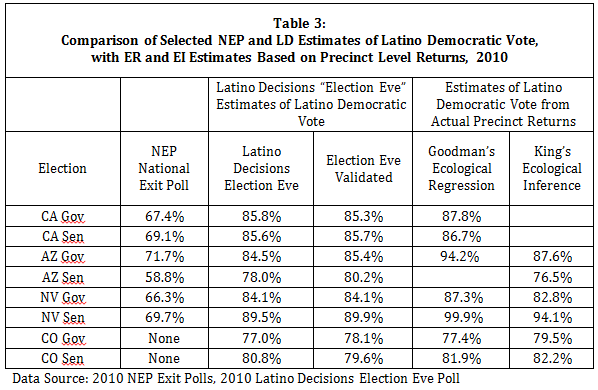Latino Decisions is partnering with the National Council of La Raza, SEIU, and America’s Voice to conduct an election eve poll of Latino voters in eight key states: California, Nevada, Arizona, New Mexico, Colorado, Texas, Illinois, and Florida. The results will be released here on our website on election night, at 8pm local time in each state, as the polls officially close.
Why an “Election Eve” Poll?
Latino Decisions will be interviewing a sample of 400 respondents from each of 8 states in a state-stratified sampling frame. The margin-of-error for each state is +/- 4.9%, and the margin of error for the entire sample of 3200 respondents is 1.7%. By restricting our interviewing to extremely high propensity voters (identified by vote history) who report being almost certain to vote or report actually having voted, we mimic the turned out electorate with only modest remaining error. However, the sampling error for an election day exit poll of Latino voters, conducted by the major media partners has been proven to be biased.
Since CNN and the pooled media exit polls break out vote results by race and ethnicity, one might wonder what the value is of our election eve take. Exit polls, designed to capture the approximate two party vote share, are structured to capture the distribution of the entire population of a given state, not the distributions of sub-populations. For some (gender, for example), the distribution is effectively constant. But both regional concentrations and neighborhood segregation significantly complicates racial and ethnic sub-group analysis. Specifically, Latinos and African Americans who appear in the national and statewide voter exit polls are not representative of all Latino or African American voters statewide, but rather, are more likely to be drawn from low density, primarily white precincts. A post-2004 reexamination (Leal et al 2005) of the exit polls whose Latino estimates diverged substantially from all pre-election polling found that precincts with significant minority majorities—which represent the demographic reality of most minority voters—are wildly underrepresented in the national frame. Those Latinos and African Americans drawn into the sample are more suburban, higher income, more educated and more assimilated than the national draw. Further, the Latino population captured in exit polls is significantly skewed towards English-dominant.
One solution, albeit an expensive one, is to restructure the exit poll methodology to incorporate a representative share of homogenous Latino precincts (Barreto et al 2006). Historically, the William C. Velasquez Institute had pioneered Latino exit polling, and provided much more accurate data than the national Edison-Mitofsky polls. Alas, there has not been meaningful adjustment in the national exit pool methodology along these lines to address the long-standing shortcoming. As a consequence, we have significant reasons to expect that the sub-group estimates we will be offered on Tuesday night will be in error.
A second factor to consider is that exit polls are seldom designed for state-level inferences. That is, while some states may have numerous precincts appear in the sample frame, the collection of interviews from that state are not a representative sample. By contrast, our election eve poll is stratified by state, meaning that the Latino estimates we produce are valid on a state-by-state level and significantly more informative regarding some of the hotly contested races in which Latino voters are likely to have an impact. The most important feature of any survey or poll is that everyone across the state has an equal chance of being selected into the sample, which is assured in an election eve telephone survey and not possible in a polling place exit poll, where the number of polling places selected is very small.
Finally, the growing prevalence of early voting—either as a formal option or in the accelerating rate of absentee balloting—means that exit polls have a difficult time incorporating a sizable segment of the electorate, often times a portion more politically motivated and engaged than the polling-place voters who turn out on election day. Even with the combination of pre-election surveys of absentee voters, the probability of selection is different in each mode creating additional weighting burdens. The size of the absentee voter share has grown in some states to almost half the turned out electorate, so the error this practice introduces to exit poll estimates is significant. There is good evidence, including the 2008 Minnesota Senate election and countless others, that the distribution of votes on election day often differs significantly from the distribution of votes cast before election day. So the difficulty of including early voters in exit polls has the potential to introduce significant error in their projections.


